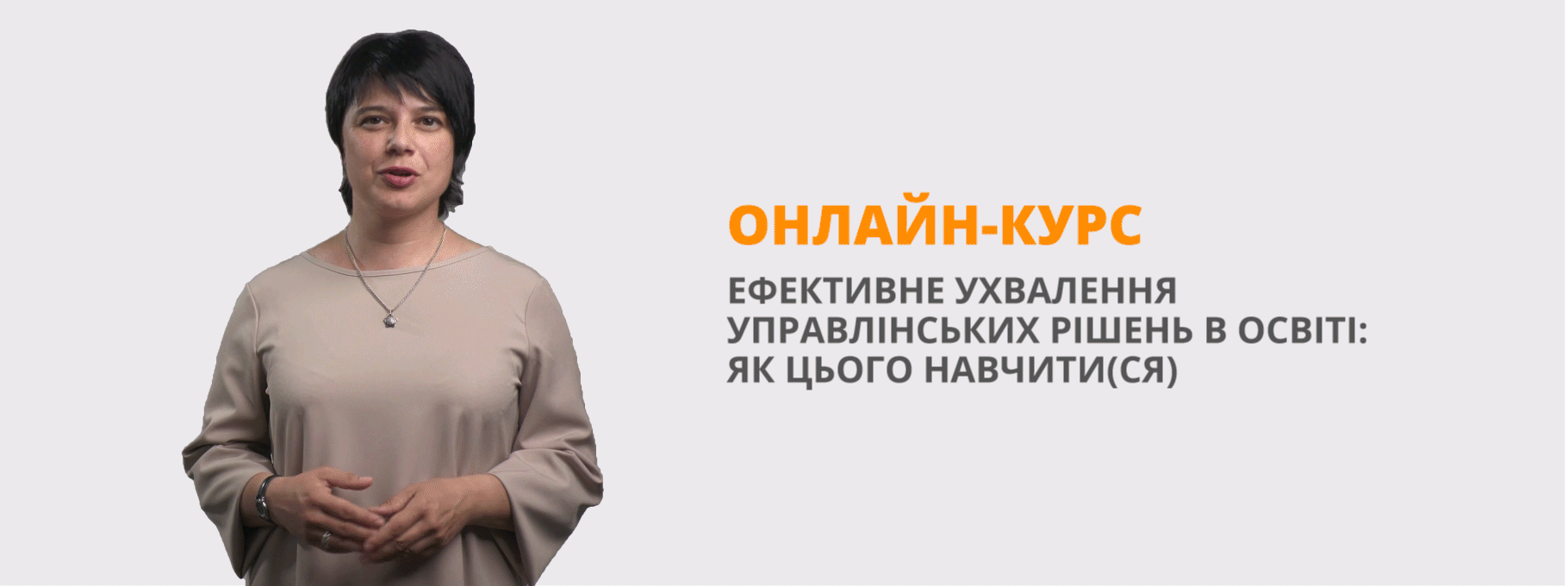Урок англійської мови у 5 класі на тему: «Україна — наша Батьківщина»
“Хто не любить свою країну, той не любить нічого" (Гордон Байрон)
Тема уроку: “Україна – наша Батьківщина".
Навчальні цілі:
1.Повторити та закріпити вживання базового лексичного матеріалу.
2.Розвивати навички усного мовлення за темою: “Батьківщина".
3.Формувати навички читання та говоріння.
4.Практикувати учнів у прослуховуванні незнайомого тексту.
5.Виховувати почуття гордості за нашу Батьківщину.
Iryna Kotyk,
a teacher of English
School # 99,
L’viv
To Our Day of Independence dedicated
The lesson is based on the course-book by O.Karpiuk , “English 5” (Unit 10, We Are Ukrainians)
“He, who loves not his country, can love nothing.”
Gordon Byron
Subject of the lesson: Ukraine is Our Motherland (Ukraine in a Nutshell[1])
Objectives:
1. to revise and extend basic vocabulary;
2. to practice talking about our Motherland;
3. to practice listening skills;
4. to develop reading and speaking skills;
5. to deepen pupils’ knowledge about the native country;
6. to develop a spirit of pride in our Motherland.
Equipment: pupil’s book O.Karpiuk “English 5” and class audio cassette to this book, a table “Only Facts”, a paper sunflower, handouts with the tasks, a map of Ukraine, a tape-recorder, Ukrainian symbols – a flag and a coat of arms, pictures of Ukrainian scenery and Kyiv, an audiotape of the Ukrainian song: S.Rotaru - ”Odna_kalyna…”(karaoke), an audiotape of the song “Tall Shops” from the book “Super Songs”(songs for very young learners).
Time: 45 min.
Lesson Procedure.
- Greeting (1 min.)
- Introduction (1 min.)
The presentation of the topic and the aims of the lesson.
- Warming-up activity (3 min.)
A short informing program “Only Facts (politics, cultural events, sport events in Ukraine, weather).
- Revision of the subject (20 min.)
- brainstorming (4 min.);
- speaking about our people, flag, language (2 min.);
- Blitz-quiz (students get handouts) – key facts about Ukraine (4 min.);
- reading of the poem (students get handouts) (4 min.);
- making the questionnaire (students get handouts) (2 min.);
- reading and speaking about Kyiv (4 min.).
A BREAKE “TALL SHOPS” (2 min.)
- Listening (5 min.)
- presenting of the text for understanding general idea;
- listening: setting the task;
- post-listening activity: choose a) or b) and complete the sentences.
- Speaking (4 min.)
- well-known people;
- holidays in Ukraine (students get handouts);
- Writing (students get handouts) (5 min.)
Write an invitation card (invite your friend from abroad to visit our country).
- Summing-up (3 min.)
Song “The Ink is Black, the Page is White”. Мarks.
- Home-task (1 min.)
LESSON
І.GREETING (1 min.)
Teacher: Good morning! Good morning! Good morning to you!
Good morning! Good morning! How are you?
Pupils: Good morning! Good morning! Good morning to you!
Good morning! Good morning! We are fine! Thank you!
II. INTRODUCTION (1 min.)
The presentation of the topic and the aims of the lesson.
Teacher: We are going to discuss a very interesting subject. If you look at the blackboard you’ll see that the topic of our lesson is “Ukraine is our Motherland. Ukraine in a Nutshell”. At our lesson we’ll remind some facts from the history of Ukraine, we’ll read the text, we’ll sing a song.
By the end of the lesson you should be able to tell about our country, people, our capital and holidays.
III. WARMING - UP ACTIVITY (3 min.)
Teacher: Let’s start our lesson with a short informing program “Only Facts”. Have a look at our table:
|
ONLY FACTS |
|
|
|
|
Today in our program: - POLITICS
- CULTURAL EVENTS
- SPORT EVENTS
- WEATHER
What is the news in this area: POLITICS
Possible pupils’ answers:
- Our president met important guests in Kyiv.
- The deputies adopted a new law.
- The parties prepare for new elections.
- Our Prime Minister visited Poland.
- A big meeting took place at the building of the Supreme Rada.
Teacher: What about CULTURAL EVENTS.
Possible pupils’ answers:
- A new exhibition was opened in Kyiv.
- A big concert took place in Kharkiv.
- A concert of young singers took place in Donets’k.
- A new book was published.
Teacher: SPORT EVENTS.
Possible pupils’ answers:
- Our Ukrainian team won a match.
- A new (football, hockey, basketball…) season was opened.
- Our sportsmen were the 1st in the competition.
Teacher: And at last some words about the WEATHER.
Possible pupils’ answers:
- It will be cold and frosty.
- It will be snowy.
- It will be windy.
- It will not be rainy.
- It will be slippery.
- The temperature will be 3 –6 degrees above zero.
IV.REVISION OF THE SUBJECT (20 min.)
a) Brainstorming (4 min.)
Teacher: Well done!
Now, open your exercise-books, write down today’s date, day, topic and the proverb “EVERY BIRD LIKES IT’S NEST”.
Who can translate the proverb?
Pupil’s answer: Кожна пташка любить своє гніздечко.
Teacher: You are right! Let’s speak about our nest Ukraine.
Please, use your imagination and write down your answers to the question “What are the first things you think of when you think of Ukraine?” (While listening to a calm Ukrainian melody of the song “Odna Kalyna…”,the pupils are writing down their ideas in their exercise-books.)
Possible pupils’ answers: music, pictures, art, poets, nature, books, people, language, symbols, cities, towns, capital, history, holidays, friends, school, family…
b) speaking about people, flag, language.
Teacher: You understand that our list can be prolonged, but the time is limited. Imagine that our country is a sunflower which presents our country Ukraine.
Let’s begin our work with some petals of our sunflower: “people”, “language”, “symbols”. What can you tell about our people?
Possible pupil’s answer: I think that our people are talented, hard-working, friendly.
Teacher: What is the national language?
Pupil’s answer: We have our own language. The national language is Ukrainian.
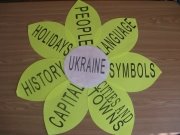 Teacher: What are our symbols?
Teacher: What are our symbols?
Pupil’s answer: The symbols are our flag and trident.
Teacher: What does our trident symbolize?
Pupil’s answer: It symbolizes our unity.
Teacher: What can you tell about our flag?
Pupil’s answer: Two colours are on our flag: yellow and blue. Yellow symbolizes golden fields of grain and a yellow sun. Blue symbolizes a blue sky.
c) Blitz-quiz (pupils get handouts – key facts about Ukraine) (4 min.)
Teacher: And now a BLITZ-QUIZ, take the cards from the envelopes and put your question, choose one pupil to answer. Be quick.
The example of the handout:
Blitz – quiz
|
Possible pupils’ answers:
- The territory of Ukraine is 603,700sq km.
- It is a large country.
- Yes, it is. Ukraine is bigger than Germany.
- Yes, it is. Ukraine is smaller than France.
- Ukraine borders on seven countries.
- There are twenty-four regions and the Republic of Crimea.
- The largest regions in Ukraine are Odesa, Dnipropetrovs’k, Chernihiv, Kharkiv regions.
- The biggest cities are Kyiv, Kharkiv, Donets’k, Odesa, Dnipropetrovs’k.
- The main rivers of Ukraine are the Dnieper, the Dniester, the Buh and the Donets.
- Yes, it is. We have many plants and factories.
- Yes, it is. Ukraine is an independent country.
- I think the favorite game is… To my mind it’s…(football, basketball…).
- I think the tastiest Ukrainian food is… To my mind it’s…(borsch, varenyky…).
- Ukraine is the nicest country in the world, we live here, we have friends here…
d) reading of the poems (pupils get handouts)(4 min.)
Teacher: Where do people live in Ukraine?
Pupil’s answer: People live in the cities, in the towns and in the country.
Teacher: Good! I want to give you a very interesting task. Look through these cards, your task is to fill in the gaps using the words from the small table.
(While all pupils of the group are doing the task, two other pupils are filling in the questionnaire. They are given two separate handouts with the question and the table. They are allowed to come up to each pupil of the group and ask the question from the questionnaire and to fill it in. After that these two pupils analyse the results at the bottom of the table.).
The example of the handout (a poem):
Where Do People Live?
Some people live in the (1)________Where the houses are very small. Some people live in the (2)_____ Where the houses are very tall. But in the country where the houses are (3)______, The gardens are very (4)_________. And in the city where the houses are (5)_____, There are no gardens at all. E. Segal |
The keys to the poem: (1) country, (2) city, (3) small, (4) big, (5) tall.
The pupils read the poem with the answers.
e) Checking the results of the questionnaire.
Teacher: Let’s check the results of our questionnaire, the first question:
The example of the handout (a questionnaire):
|
Where would you like to live in the city or in the village?
|
The possible presentation of the analysis of the questionnaire (the first pupil): My question was… Fourteen pupils were asked. Nine pupils chose the answer “city” and five – “village”.
The teacher may also ask pupils why they chose this or that answer.
Possible pupils’ answers:
city – There are many cinemas, theatres, clubs, supermarkets…
village – There is a beautiful nature, we can swim in the river, go to the forest…
A BREAK “TALL SHOPS”(2 min.)
(The pupils are imitating different movements, they show “tall, up and down, in and out, walking all about”). The tape-script of the song (taken from the book and class audio cassette “Super Songs”-songs for very young learners, Oxford University Press):
Tall shops in the town.
Lifts going up and down.
Doors going in and out.
People walking all about.
f) reading and speaking about Kyiv.
Teacher: Now a very simple question – What is the capital of Ukraine?
Pupil’s answer: The capital of Ukraine is Kyiv.
Teacher: Well, all roads lead to Kyiv in Ukraine. Let’s read about our capital. (The pupils are given the copies of the text “Kyiv” from the book “English 4(5)” by T. Polons’ka , Ex.5 p.162).
Reading of the text.
Kyiv
Kyiv is the capital of Ukraine. Kyiv is a large and nice city. It is one of the oldest cities in Europe. Kyiv stands on the river Dnieper. It is a very green city. There are many chestnut trees and flowers there. Khreshchatyk is the main street of the Kyivites. There are many monuments in this city: the monuments to Taras Shevchenko, Bohdan Khmelnytsky, Prince Volodymyr and others. There are many fine churches, museums, libraries, cinemas and theatres in Kyiv.
Kyiv is the city of students because there are many universities and institutes there. Kyiv is a Hero City.
Kyiv is the seat of the President and the Supreme Rada.
The Kyivites love their city very much.
Teacher: Let’s check the results of the second question of our questionnaire:
The example of the handout (a questionnaire):
|
Have you ever been to Kyiv?
|
The second pupil, who filled in the questionnaire, analyses the information from his/her table. Possible pupil’s answer: My question was… Fourteen pupils were asked. Six of them gave the answer “yes” and eight – “no”.
Teacher: Some of you have already visited Kyiv. What other facts can you add besides the text?
Pupils’ answers: - Kyiv was founded by Kyi, Schek, Khoryv and their sister Lybid.
- There are many schools in Kyiv.
- I saw the Metro in Kyiv, it is faster than the buses, trams, trolley-buses.
- Kyiv is a green city.
V.LISTENING (5 min.)
a) presenting of the text for understanding general ilea.
Teacher: Well, now listen to the text and guess which part of our sunflower this text belongs to? The pupils listen to the text “Who Were Kozaks?” (The text is taken from the pupil’s book “English 5” by O.Karpiuk Ex.1p.154 which pupils have, but the pupils are not allowed to open the book while listening for the first time.
THE FIRST LISTENING
The tape-script of the text.
Who Were the Kozaks?
The word kozak means a free and independent man.
First Kozaks lived in Ukraine many hundreds years ago. But the most famous are Zaporizhian Kozak. They were very brave and strong. They didn’t like tsars. They didn’t want to work for masters. They loved freedom. They made their own state - Zaporizhian Sich. They called their leader ‘koshovyi otaman’. The bravest one was Ivan Sirko. He won many victories.
The main idea of Zaporizhian Sich was to fight for independence of their native land.
Scientists say that Zaporizhian Sich was a good example of a democratic state.
Zaporizhian Kozaks were really free and independent people.
Russian Empress broke up Zaporizhian Sich.
Legends and songs brought us the name of these national heroes: Bohdan Khmelnytskyi, Petro Doroshenko, Ivan Mazepa, Petro Sahaidachnyi. Their names will live in hearts and minds of true Ukrainians forever.
Teacher: So what theme are we going to discuss?
Pupil’s answer: The text is about “kozaks”. We are going to speak about our history.
Teacher: Open your books Karpyuk at page 154-155. Who can guess the meaning of the words from the table “New Vocabulary”?
The pupils and the teacher elicit the meaning of the words.
Teacher: We’ll listen to the text once more and your task will be to choose the correct answer: a) or b). Look through Ex.2 p.155.
Ex.2 p.155(Choose a) or b) and complete the sentences.)
- Kozaks were…
- not independent people
- free people
- The main idea of Zaporizhian Kozaks was…
- to be independent
- to work for their masters
- Kozaks called their leader…
- tsar
- koshovyi otaman
- Ivan Sirko
- broke up Zaporizhian Sich
- won many victories
- Kozaks fought for…
- independence of their native land
- Russian Empress
- Kpzaks were men who loved…
- freedom and independence
- their masters
THE SECOND LISTERNING
Pupils’ answers.
The keys to Ex.2p.155: 1)b, 2)a, 3)b, 4)b, 5)a, 6)a.
VI.SPEAKING (4 min.)
a) well-known people.
Teacher: Now look at the portraits of the men in Ex.3p.155. Do you know them? Who where these people? (In the pictures the pupils can see Petro Sahaidachny, Ivan Mazepa, Bohdan Khmelnytskyi.)
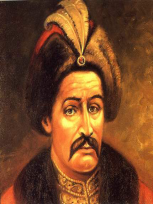
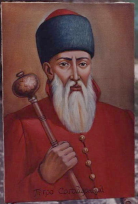
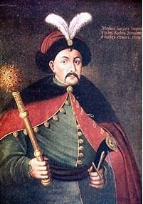
Petro Sahaidachny Ivan Mazepa Bohdan Khmelnytskyi
Pupil’s answer: They were our Ukrainian hetmans.
Teacher: So, which of the historical events do you consider to be the most important?
Pupils’ answer: Our people fought for independence, so, the most important holiday is the Day of Independence.
b) holidays in Ukraine (pupils get handouts).
Teacher: You are right. Fighting for independence is one of the most important pages in our history. Our people preserve our traditions. We like to celebrate holidays. Look, this is the last petal of our sunflower – “HOLIDAYS”. I’ll give you these envelopes. Your task is to match holidays and dates.
The example of the handout:
|
MATCH HOLIDAYS AND DATES New Year’s Day is on the 7th of January Christmas is on the 1st of January Easter is on the 28th of June Mother’s Day is on the 1st of September
Day of Independence of Ukraine is on the 24th of August Day of Knowledge is on the second Sunday in May Constitution Day is in March or April |
The answers:
|
MATCH HOLIDAYS AND DATES New Year’s Day is on the 1st of January Christmas is on the 7th of January Easter is in March or April Mother’s Day is on the second Sunday in May Day of Independence of Ukraine is on the 24th of August Day of Knowledge is on the 1st of September Constitution Day is on the 28th of June |
(Pupils do the task in two). Pupils read the answers. While checking the task the teacher may ask some additional questions:
e.g. Do you like this holiday?
Who do you celebrate this holiday with?
What do you usually do before this holiday?
How do you usually celebrate this holiday?
VII.WRIGHTING (5 min.)
The pupils get handouts.
Teacher: When we celebrate holidays we like to receive guests. Imagine that you have a friend from abroad. Write the invitation card. Tell some words about yourself, our country, what holiday you are going to celebrate. Use the prompts. You may also decorate you invitation card. (On the previous lesson the pupils were asked to bring pencils and felt-pens.)
The example of the handout:
|
Dear friend! My name is _________. I am from ____________. I live in Lviv. _______________ is a great holiday. In Ukraine we _______________ ______________________________. Please visit our country. You’ll see that our people are ____________,______________,____________. Your ___________.
|
Possible pupil’s variant:
|
Dear friend! My name is Ira . I am from Ukraine . I live in Lviv. The Day of Independence is a great holiday. In Ukraine we celebrate it on the 24th of August. Please visit our country. You’ll see that our people are talented, hard-working, friendly. Your Ukrainian friend. |
VIII.SUMMING-UP (3 min.)
Teacher: It was the last petal of our sunflower. Today we spoke about our country, our people. We are Ukrainians! We are proud of our country! We are happy to live in Ukraine! Let’s sing a song which we have already learnt “The Ink is Black, the Page is White”. (The song is taken from the pupil’s book “English 5”, O.Karpiuk, Ex.3p.153.
The pupils and the teacher sing the song “THE INK IS BLACK, THE PAGE IS WHITE”.
The tape-script of the song:
The ink is black, the page is white,
Together we learn to read and write.
To read and write.
And now a child can understand,
Ukraine is our Motherland.
The board is black, the chalk is white,
The words stands out so clear and bright,
So clear and bright.
And now at last we clearly see
Ukrainian people are Family.
The child is black, the child is white,
The whole world looks upon the sight,
A beautiful sight.
For very well the whole world knows,
This is the way our Friendship grows.
Teacher: I want to tell you thank you for today’s lesson. You were very active, hard-working and creative. Your marks are...
IX.HOME-TASK (1min.)
Teacher:
Think about the design of a new stamp for our country, next time we’ll listen to all your ideas and deal with a project work.
References:
- Linda Diabina. Wonders of Ukraine.// English.-2004-#29-30 (221-222) – p.17-19.
- І.Б.Луценко. Методична розробка уроку з теми „Україна”, „Київ – столиця України”, „Міста України” (9 клас)// Англійська мова та література.- 2004. - №1(47) – ст.18-19.
- “Ukraine in a Nutshell” / Видання здійснене видавництвом „Контекст”, за підтримки Представництва „Пірсон Ед’юкейшн” („Лонгман”) в Україні, 2004. – с. 3, 8, 9, 12.
- О.Д.Карп’юк, Англійська мова: Підручник для 5-го класу загальноосвітніх навчальних закладів. – Тернопіль: Астон, 2005. – с:144-157.
- О.Д.Карп’юк, Англійська мова: Підручник для 4 класу загальноосвітніх навчальних закладів. – Київ, Навчальна книга, 2004. – с.35.
- Т.К.Полонська, English: Підручник для 4(5)-го класу загальноосвітніх навчальних закладів. – Київ; Ірпінь: ВТФ „Перун”, 2004. – ст. 147, 162-163, 165-168, 170-171.
- “Super Songs”: Songs for very young learners. – Oxford University Press, 2003. – p.22.
1
[1] The subtitle is taken from the book “Ukraine in a Nutshell” / Видання здійснене видавництвом „Контекст”, за підтримки Представництва „Пірсон Ед’юкейшн” („Лонгман”) в Україні, 2004.


про публікацію авторської розробки
Додати розробку
